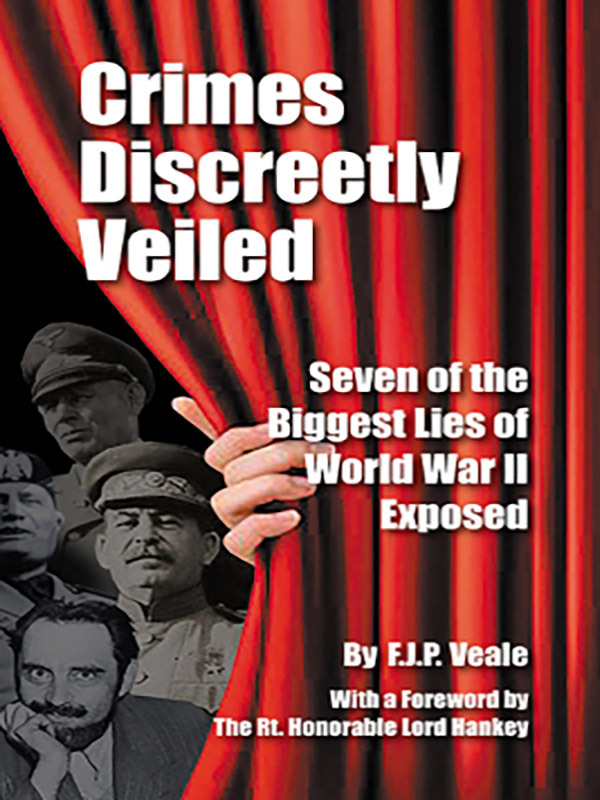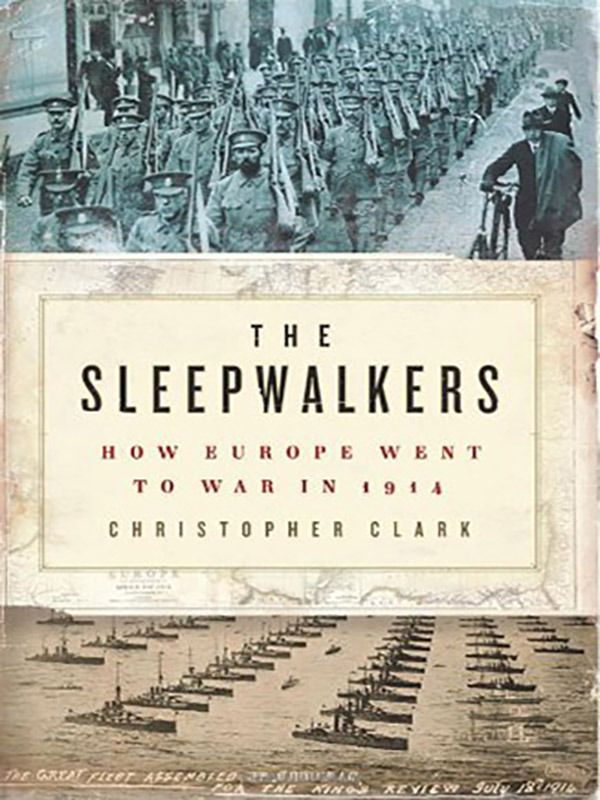Crimes Discreetly Veiled
$27.50
By F. J. P. Veale. With a foreword by the distinguished Lord Hankey. A brand-new edition of the classic work by distinguished English historian F. J. P. Veale, dealing comprehensively with seven of the most enduring and appalling lies created by the Allies during and after the Second World War.
This incredible work of historical revelations has been suppressed ever since it first appeared in 1958. This edition has been completely reset and updated with numerous footnotes to bring the present-day reader up to date with the events and personalities mentioned therein. The new edition also contains all four original maps and 36 new and unusual illustrations.
- Description
Description
By F. J. P. Veale. With a foreword by the distinguished Lord Hankey. A brand-new edition of the classic work by distinguished English historian F. J. P. Veale, dealing comprehensively with seven of the most enduring and appalling lies created by the Allies during and after the Second World War.
The first lie to be uncovered is that of the image of “Uncle Joe” Stalin — who was transformed from an “evil Communist dictator” into “a fighter for freedom” when the Soviet Union was invaded by Nazi Germany. The author shows how the rest of the Allied leaders deliberately covered up and lied to their public and followers about the Soviet Union’s true nature. They were forced into an embarrassed and largely silent retraction when Stalin revealed himself and the Soviet Union for what they were by imposing an evil 50 year-long dictatorship on half of Europe.
The second lie deals with the massacre at Katyn — where the Communist secret police murdered over 21,000 Polish officers and intelligentsia in cold blood. The author’s review does not concentrate on the facts of the crime itself, but rather on the staggering hypocritical reaction and cover-up of the Soviet Union’s murderous activities by the Western Allied powers — and their willingness to overlook all of the Soviet Union’s crimes against humanity based purely on their hatred of Nazi Germany.
The third lie deals with what the controlled media and establishment historians still maintain was Benito Mussolini’s “execution”. In fact, as the author clearly shows, this was no execution, but a blatant murder carried out without authorisation of any sort, and committed to cover up the theft of millions in state gold and reserves by the Communist partisans who then used it for themselves and to fund the Communist Party of Italy. The author shows how the original partisans involved in arresting Mussolini — and who appeared to be honest — were murdered by their Communist compatriots to prevent them from revealing the truth about the stolen reserves.
The fourth lie deals with the largely suppressed activities of one of France’s greatest mass murderers — Doctor Marcel Petiot — who carried on his murderous trade during the war. His murderous spree was undiscovered for years because mysterious disappearances resulting from the flood of murders committed by the Communist “resistance” were so commonplace that the disappearance of his sixty-odd victims raised no eyebrows. In fact, Petiot was only exposed when his corpse incinerator system — located in a house in the heart of Paris — broke down. The lesson, the author reveals, is that the claimed “heroism” and deeds of the Communist “resistance” for the greatest part consisted of random murders of anti-Communists, and the creation of an atmosphere of terrorism, in which a lunatic mass murderer could operate undetected.
The fifth lie deals with what has become known as the “Marzabotto Massacre” in Italy. It is claimed that this incident was a mass murder carried out by a German unit in late 1944 against an innocent village of Italian civilians. Through a clinical evaluation of all the available evidence, the author shows that the German commander, Major Walter Reder, never even set foot in the place where the deed was alleged to have taken place. Furthermore, the author shows, the “massacre” never actually took place and was a manufactured post-war Communist myth that even the American and British military investigators dismissed as propaganda when they first investigated it in 1945. Despite this, Major Reder was imprisoned for over 40 years for this “massacre,” and the event is still propagated as fact to this very day.
The sixth lie deals with the arrest and imprisonment of the German commander of the garrison at the French city of Brest in Brittany, General Hermann-Bernhard Ramcke. This general, tasked with holding out in the city and destroying the port facilities so that the invading Allies could not use it to land reinforcements, succeeded in his goal. When it became clear that the American forces were going to lay siege to the city, General Ramcke arranged a truce to allow the evacuation of every civilian in the city. When his task of destroying the docks was completed, he then surrendered to the besieging American army. After the war, General Ramcke was put on a show trial by the French and charged with causing the death of the civilians (who he had actually sent out of harm’s way) and destroying the city of Brest—even though the 39 day-long American Air Force bombing campaign had been responsible for the city’s destruction. The general’s trial included testimony in his favour given by his American battlefield opponent, General Troy H Middleton, who stated that General Ramcke had committed no crimes and had acted honourably at all stages of the conflict. Despite this, General Ramcke was found guilty of “war crimes.”
The seventh lie deals with the case of Grand Admiral Eric Raeder and his imprisonment in Spandau Prison on the charge of “waging aggressive war” for arranging the invasion of Norway in 1940. The author reveals that the Allies at the Nuremberg Trials could not decide on the proper definition of “aggressive war”— because any definition they could think of would include their own aggressive wars, particularly those of their fellow judges and allies at Nuremberg, the Soviet Union. In addition, the author shows that the British had in fact been the first to draw up and physically implement an invasion of Norway before the Germans had even started with their plans. Thus, Admiral Raeder was sentenced to prison for doing exactly what the British had done in 1940, namely arranging an invasion of Norway.
This incredible work of historical revelations has been suppressed ever since it first appeared in 1958. This edition has been completely reset and updated with numerous footnotes to bring the present-day reader up to date with the events and personalities mentioned therein. The new edition also contains all four original maps and 36 new and unusual illustrations.
Contents
- Foreword by the Right Hon. Lord Hankey
- Chapter I—Introduction: The Great Stalin Myth
- Chapter II—The Katyn Mass Murder
- Chapter III—The Murder of Benito Mussolini
- Chapter IV—An Opportunist of Genius
- Chapter V—The Marzabotto Affair
- Chapter VI—The Fate of a Hero
- Chapter VII—The Super-Ersatz Crime
- Index
Paperback, 304 pages 6” x 9”








